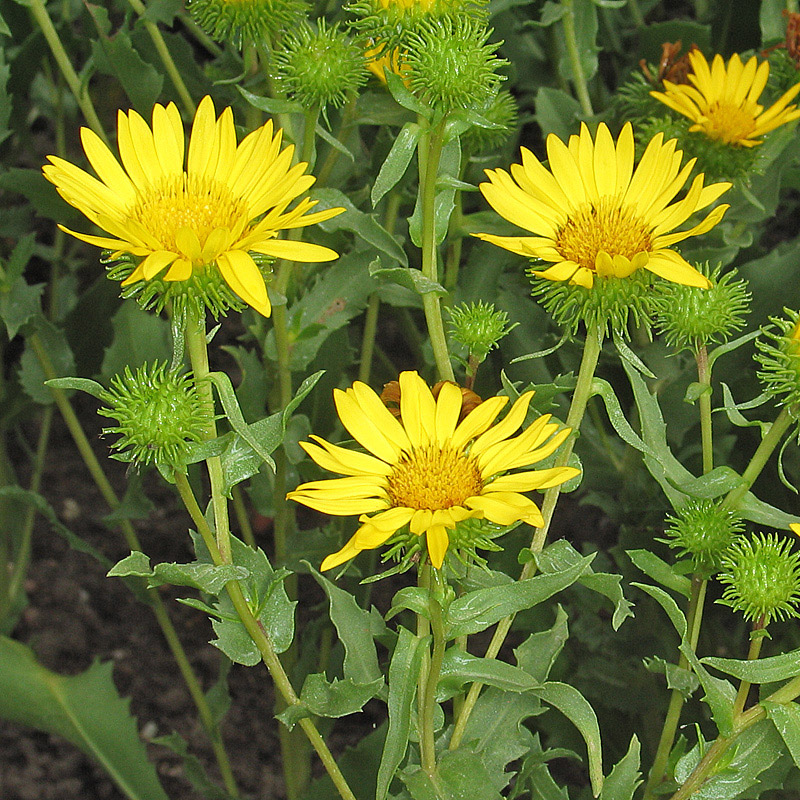Botanical name
Grindelia sp. Willd.
Family
Asteraceae
Common name
Gumplant, Gumweed.
Information about the plant
Grindelia, or gumweed, is a composite plant native to arid and semi-arid regions (dry areas) of western North America, ranging from Mexico to Canada. A distinctive feature of all species is that the surface of the stem, the leaves, and the flower bracts are covered with a sticky resin, which has led to the plant being named ‘gumweed’ in German. Around 60 different species are known, two of which are used medicinally: the hairy gumplant or hairy gumweed (Grindelia hirsutula Hook. & Arn.; synonyms: G. robusta Nutt., G. humilis Hook. & Arn., G. camporum Greene) and the curlycup gumweed (G. squarrosa (Pursh) Dunal).
The plants are biennial, forming a rosette of leaves in the first year and a branched shoot with alternate leaves in the second. At the ends of the shoots are yellow flower heads, 2 to 5 cm in diameter, which are covered with a whitish resin during the bud stage. This resin is secreted by the glandular scales of the bracts. Resin ducts can also be found inside the stem and leaves. The resin production of Grindelia is a phytochemical adaptation to the arid lifestyle of the species (evaporation protection) and has been shown to have a feeding effect on aphids and butterfly caterpillars. The flowering time is from May to June.
Medicinally used parts of plants (herbal drug)
The dried stem tips collected at flowering time, consisting of flowers, leaves, and stems (Grindeliae herba), are used.
The commercially available drug comes from the USA and Canada.
Constituents of the herbal drug
Grindelia herb contains a resin of labdane diterpenes, flavonoids, saponins, acetylenes, and essential oil.
Quality of the drug
The quality of grindelia herb (Grindeliae herba) is specified in the European Pharmacopoeia (Ph. Eur.). According to the pharmacopoeia, the herb of the hairy gumweed (G. hirsutula) and the curlycup gumweed (G. squarrosa) can be used.
Medical applications
Recognised medical use
The HMPC has classified grindelia herb as a traditional herbal medicinal product (see ‘Traditional use’).
ESCOP: For productive cough and catarrh of the upper respiratory tract; these indications are based on human experience and long-standing use.
Traditional use
The HMPC has classified grindelia herb as a traditional herbal medicinal product (Article 16a of Directive 2001/83/EC). Based upon long-standing use, grindelia herb can be used to treat coughs associated with colds.
Herbal drug preparations in finished dosage forms
- Cut grindelia herb for tea preparation
- Fluid extract in syrup
- Tincture in drops
- Grindelia robusta homeopathic mother tincture in drops
Dosage
Finished medicinal product: See patient information leaflet.
Tea: Drink 1 cup of hot grindelia herb tea several times a day. Daily dose: 4 to 6 g drug.
Preparation of a tea
Pour approximately 150 ml of boiling water over 2 to 3 g of finely chopped grindelia herb and strain after 10 to 15 minutes.
Notes
No safety studies have been published on the use of grindelia herb during pregnancy and lactation. The use of grindelia herb in children and adolescents under the age of 18 is not recommended due to a lack of evidence.
Side effects
In case of allergy to Asteraceae, the use of grindelia herb should be avoided due to a possible cross-allergy.
Interactions
None known.


